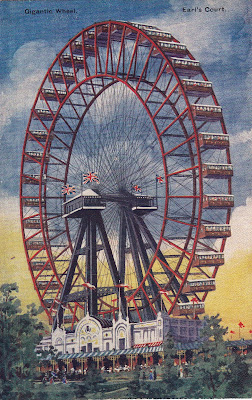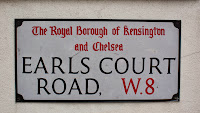Little Chelsea Then and Now
Fulham Road
 |
| The old St. Stephen's Hospital since replaced by the new Chelsea and Westminster Hospital. Originally the site of Shaftsbury House, built in 1635 and rebuilt in 1858 as the St. Georges Workhouse. The pub on the right was the Somerset Arms until 1983, it is now a pizza restaurant. |
 |
| Same view today. |
Little Chelsea is centred around the Fulham Road, which has been recently referred to as "The Beach". The first reference to Little Chelsea is, according to the Survey of London, in 1618 as "Lylle Cheley". It was distinct from Chelsea from 1650 to 1840 when it was absorbed into Greater Chelsea. {Chelsea Scraps, 1897}.
Richard Edmonds in his book "Chelsea, From Five Fields to Worlds End", noted that Samuel Pepys recorded in his diary of May 1663; "so walked to Little Chelsea, and very merry".

|
Map by Rocque, 1746
Hollywood Road
|
 |
To Miss M. Webb; "My Dear Mabel, Thank you very much for the postcard. I am coming home on Friday [tomorrow] do come round soon, it seems ages since I saw you, it is a black fog here, cant see across road. Have not had any time to go anywhere. Hope you are keeping well, with much love Ethil. Do you like this card, it is the street where I am staying.
|
Note the Hollywood Arms sign on the right and how little has changed.
A can be seen in the map it was originally called Hollywood Grove. According to the Survey of London there are records in the 1660's of a sizeable brick house owned by Henry Middleton to the immediate west of Hollywood Road where Tesco now is. The family were extensive landowners both in the area and also in the southern States of America, he was Governor of South Carolina, and in Barbados. His son sold the house in 1776, and his cousin Arthur Middleton was one of the signatories of the Declaration of Independence. The house was bought by Louis Lochee where he built a Military Academy. In 1784 his grounds saw an ascent by two balloonists, Blanchard and Sheldon. An event that was commemorated in the sign of the Hollywood Arms pub, since removed.
Lochee died in mysterious circumstances when involved in the independence movement to liberate Brabant from the Austrians. His death was recorded in The gentleman's Magazine in June 1791; "At Lisle in Flanders Lewis Lochee Esq. late Lieutenant Colonel of the Belgic Lion, and former keeper of the Royal Military Academy in Chelsea".
The famous Bistro Vino restaurant, owned by Mr. Eddows, was on the corner with Fawcett Street.
Cathcart Road
Cathcart Road was named in 1865 after the Crimea War hero Lord Cathcart, whilst Tregunter Road was named in 1852 after the Gunter family home between Talgarth and Brecon in Wales.
 |
This card was unsent. It was produced by Charles Martin, 39 Aldermanbury, London E C and Printed in Prussia
|
 |
| Play time |
Nothing has really changed, Oakfield Street where we live, is just to the right. A certain James Gunter acquired the leasehold of the land owned by Louis Lochee in 1784. He was a successful confectioner with a shop in Berkeley Square. His son Robert purchased plots and, in 1836, the freeholds. By 1850 he had assembled some 93 acres of land in the area. It was his two sons Robert and James, who, on their return from the Crimean War started the major development program, starting in the 1850's with The Boltons. The architects were George and Henry Godwin.They started with St. Mary's church in 1849, at a cost of £3,000. The Boltons were built in 1850's, moving south in the 1860's, the Hollywood Pub was built in 1865 and then west to Redcliffe Square in the 1870's. Most of the 1,100 houses were built , to the Godwin's designs, by the builders William Corbett and Alexander McClymont.
Redcliffe Square
 |
To C Bennett Esq; "Dear P. Thanks for letter, The weather has been very hot but most enjoyable notwithstanding. The heat of the city is most oppresive and these night classes are a big strain. We get the Kings Birthday friday next, 29th. and I shall spend it in Bristol. I leave Thursday morning and shall return Monday morning early. I hear Mother is going down to the carnival and shall be disappointed if I don't see her. Auntie and Uncle start their holidays at the end of the week also. Love to all, A.
|
 |
| The trees have grown and carts become cars. |
Redcliffe Gardens previously Walnut Tree Walk
 |
| The card was unsent but collected, Published by F. Kehrhahn & Co, Bexley, Kent and London and Phototyped in Berlin. |
This was the prestigious north south boulevard of the Gunter Estate with very large semi-detached houses of stock brick with rich Italianate stucco dressing. As Nikolaus Pevsner noted; " Each house boasts an elaborate porch with red granite columns and stiff leaf capitals". It was named in 1869 after the Redcliffe area of Bristol where the architects had previously worked.
Drayton Gardens
 |
| Published by Malin & Cooper, stationer, 303 Fulham Road SW. Printed in Germany. |
Originally called Thistle Grove it passes north through what used to be wastelands of Brompton Heath, a wild and desolate place visited for snipe shooting. The Rev. Scott quotes Besant as describing the place as "The dreary heath, that no man may cross with impunity after dark."
The houses on the east side by the Fulham Road date from 1810's, the Mansion blocks, shown above, to the north by J. Norton date from 1894-97 and 1904. The elegant terraces further up are by the architect John Blore dating from 1846 -63.
The famous art house cinema The Paris Pullman was at number 65. It was initially built in 1910 as The Radium Picture House, re-opened in 1965 as the Paris Pullman and demolished in 1983.
Priory Walk
 |
| "I am going home on Sat. for 2 nights, I will write next week, thanks for your letter, hope to see you soon, we have all more or less suffered from headcolds and influensa here. With all love Phil" Feb 1905 |
Unchanging except for the trees.
Gilston Road
 |
| "Just a card to know how you all are getting on, and how is Walter, I hope his head is better, you might one of these days let me have a call, we are free from today till Tuesday, I shall be out tomorrow evening otherwise I expect to be in till the end of the week. How is Pammy getting on it seems ages since I last saw her. Patty is back in London but I have not seen her yet. Fondest love to all from G." May 1906 |
The spire of St. Mary's Boltons is just visible behind the trees. behind the house on the left are the Bolton Studios, 27 of them developed by the sculptor Charles Bacon in 1883-88. Artists who have lived there include Theodore Roussel and Thomas Kennington.
































































